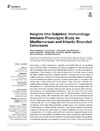Identificador persistente para citar o vincular este elemento:
https://accedacris.ulpgc.es/handle/10553/69920
| Título: | Insights into dolphins' immunology: Immuno-phenotypic study on mediterranean and atlantic stranded cetaceans | Autores/as: | Centelleghe, Cinzia Da Dalt, Laura Marsili, Letizia Zanetti, Rossella Fernández Rodríguez, Antonio Jesús Arbelo Hernández, Manuel Antonio Sierra Pulpillo, Eva María Castagnaro, Massimo Di Guardo, Giovanni Mazzariol, Sandro |
Clasificación UNESCO: | 310907 Patología 2412 Inmunología 3105 Peces y fauna silvestre |
Palabras clave: | Bottlenose Dolphin Immunohistochemistry Lymphocytes Organochlorine Striped Dolphin |
Fecha de publicación: | 2019 | Publicación seriada: | Frontiers in Immunology | Resumen: | Immunology of marine mammals is a relatively understudied field and its monitoring plays an important role in the individual and group management of these animals, along with an increasing value as an environmental health indicator. This study was aimed at implementing the knowledge on the immune response in cetaceans stranded along the Italian coastline to provide a baseline useful for assessing the immune status of bottlenose (Tursiops truncatus) and striped (Stenella coeruleoalba) dolphins. In particular, since the Mediterranean Sea is considered a heavily polluted basin, a comparison with animals living in open waters such as the Atlantic Ocean was made. Formalin-fixed, paraffin-embedded spleen, thymus, and lymph node tissues from 16 animals stranded along Italian and 11 cetaceans from the Canary Island shores were sampled within 48 h from death. Information regarding stranding sites, gender, and age as well as virologic, microbiological, and parasitological investigations, and the cause and/or the death mechanism were also collected in order to carry out statistical analyses. Selected tissues were routinely stained with hematoxylin-eosin (H&E) and with immunohistochemical techniques (IHC). For IHC analysis, anti-human CD5 monoclonal mouse antibody to identify T lymphocytes, CD20 monoclonal mouse antibody for the identification of mature B lymphocytes and HLA-DR antigen (alpha-chain) monoclonal mouse antibody for the identification of the major histocompatibility complex type II were previously validated for both species by Western-blotting technique. T-test method applied to quantitative evaluation of IHC positive cells showed a significant relationship between the number of (expression) of CD20 stained lymphocytes and normal and hypoplastic lymph nodes, respectively. No other significant correlations were noticed. Analyses for organochlorines (OC) compounds were performed in animals (no5) having frozen blubber tissue available. A simple linear regression was calculated to predict if the amount of OCs could influence the number of inflammatory cell subpopulations and a moderate negative correlation was found between the presence of high quantity of contaminants and the number of T lymphocytes. Future analysis should be aimed to understand the effect of the major immunomodulatory pathogens on sub-populations of B and T cells. | URI: | https://accedacris.ulpgc.es/handle/10553/69920 | ISSN: | 1664-3224 | DOI: | 10.3389/fimmu.2019.00888 | Fuente: | Frontiers In Immunology [ISSN 1664-3224],v. 10, 888 |
| Colección: | Artículos |
Citas SCOPUSTM
12
actualizado el 08-jun-2025
Citas de WEB OF SCIENCETM
Citations
11
actualizado el 08-jun-2025
Visitas
84
actualizado el 02-mar-2024
Descargas
81
actualizado el 02-mar-2024
Google ScholarTM
Verifica
Altmetric
Comparte
Exporta metadatos
Los elementos en ULPGC accedaCRIS están protegidos por derechos de autor con todos los derechos reservados, a menos que se indique lo contrario.
